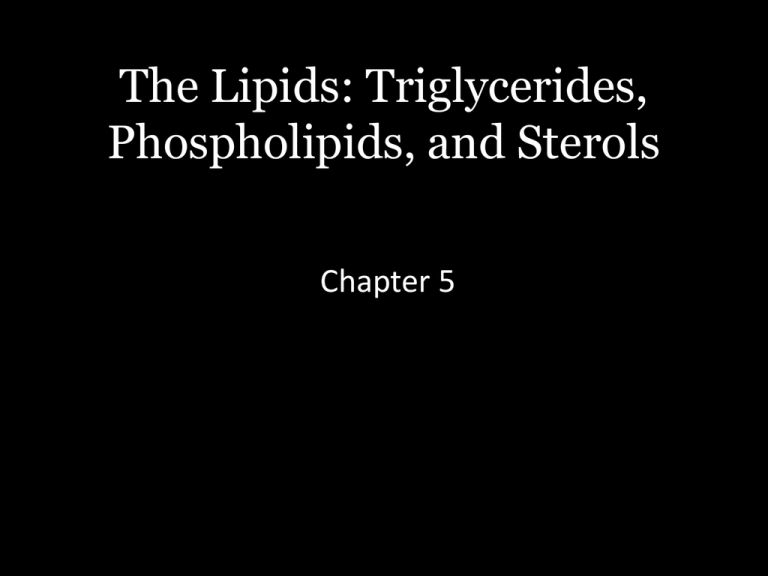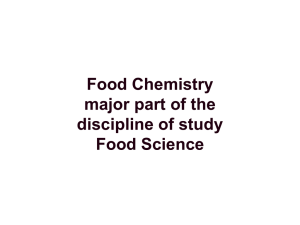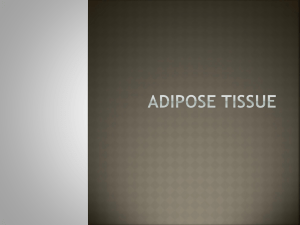
The Lipids: Triglycerides,
Phospholipids, and Sterols
Chapter 5
Introduction
• Poor health from fat consumption is seen
when a person consumes either
• Too much fat
• Too little fat
• Too much of some kinds of fat
• Lipids = Fat
– Family of lipids
• Triglycerides (TG) (fats & oils)*
• Phospholipids
• Sterols
Chemist’s View of Fatty Acids and
Triglycerides
• Lipids =
– TG, Phosolipids, and sterols
• Composed of C, H, and O
• Have more C & H = supply more E per gram
• Most are TG w/ glycerol backbones and
three fatty acids (f.a.)
Chemist’s View of Fatty Acids and
Triglycerides
• F.A. vary in C chain lengths, degree of
unsaturation, and # of double bonds (d.b.)
• Trans-fatty acids
Chemist’s View of Fatty Acids and
Triglycerides
Preview of lipids
Triglycerides: glycerol and 3 fatty acids
Fatty acids: even number of carbons
4-24Cs; 18C most common in foods
Saturated or unsaturated
Mono or polyunsaturated
Chemist’s View of Fatty Acids and
Triglycerides
• Fatty acids
– Organic acid
– Methyl group (CH3) at one end; acid group
(COOH) at other
– Usually even number of Cs
– Saturation
Chemist’s View of Fatty Acids and
Triglycerides
• Unsaturated
– Monounsaturated f.a. :
• Lack 2H atoms & have 1 d.b.
• When most of the f.a.s are monounsat its called a
monounsaturated fat
– Polyunsaturated f.a.s (PUFA)
• Lack 4 or more Hs & have at least 2 or more d.b.
• When most of the f.a.s are polyunsaturated its called
a polyunsaturated fat
Chemist’s View of Fatty Acids
Location of d.b.
Nearest the methyl end of the carbon chain
Assigned an Omega number
Omega- 3-polyunsat f.a.
Linolenic acid are essential f.a.
» Soybean and canola oils, flaxseed, walnuts
Omega- 6-polyunsat f.a.
Linoleic acids are essential f.a.
» Vegetable, i.e. sunflower, safflower, corn, and soy bean oils
Monounsaturated fatty acids
Omega-9 groups
• Oleic acid most predominate in diet
• Olive, canola oils
Chemist’s View of Fatty Acids and
Triglycerides
• Triglycerides
– Three fatty acids attached to Glycerol backbone
– Formed via series of condensation reactions
– Usually contain mixture of fatty acids
Chemist’s View of Fatty Acids and
Triglycerides pg 137
Chemist’s View of Fatty Acids and
Triglycerides
• Degree of unsaturation
– Firmness
• Polyunsaturated fats
• Saturated fats
• Length of carbon chain
– Stability
•
•
•
•
Sat fat is more resistant to oxidation
monounsat fat is slightly less susceptible to spoilage
Polyunsat fat spoils most readily
Protection from rancidity:
Chemist’s View of Fatty Acids and
Triglycerides
• Degree of unsaturation
– Hydrogenation
– Trans-fatty acids
Chemist’s View of Fatty Acids and
Triglycerides
Chemist’s View of Fatty Acids and
Triglycerides
Chemist’s View of Phospholipids
and Sterols
• Phospholipids
– Contain glycerol, 2 f.a. and a phosphate group
with a molecule of choline
– Solubility in fat and water
– Emulsifiers in food industry
– Roles
Chemist’s View of Phospholipids
and Sterols
• Sterols
– Food sources
• Cholesterol
• Plant sterols
– Roles of sterols
• Starting material for bile acids, sex hormones,
adrenal hormones, and vit. D
• Structural component of cell membranes
• Liver produces 800-1500mg cholesterol per day
• Atherosclerosis
Lipid Digestion
Fats are hydrophobic
Tend to separate from watery fluids in GI tract
Digestive enzymes are hydrophilic
Goal of fat digestion
Dismantle triglycerides for body to absorb and
use
Lipid Digestion
• Mouth
– Lingual lipase released by salivary glands
• Stomach
– Strong muscle contractions disperse fat into
smaller droplets
– Fat then exposed to Gastric lipase
Lipid Digestion
• Small intestine
– Cholecystokinin (CCK)
– Pancreatic and intestinal enzymes
– Phospholipids are hydrolyzed
– Sterols are absorbed
– Bile routes
– Enterohepatic circulation
– Soluble fibers are effective
• in trapping some bile and
• excreting it from the body thru the large intestine
Emulsification of Fat by Bile
Hydrolysis of a Triglyceride
Enterohepatic Circulation of Bile
Lipid Absorption
• Directly into bloodstream
– Glycerol and short- & medium-chain fatty acids
diffuse and are re-absorbed directly into the
bloodstream
• Lymphatic system
– Larger molecules, Monoglycerides and long-chain
f.a.s, form micelles that get reabsorbed, and are
reformed into new triglycerides. With protein they
are transported by chylomicrons
– When packaged with protein it’s then transported
so that cells all over body may select needed lipids
Lipid Transport
Lipid transport is made possible by a group of
vehicles known as lipoproteins
Four main types of lipoproteins
Chylomicrons
Very-low-density lipoproteins (VLDL)
Low-density lipoproteins (LDL)
High-density lipoproteins (HDL)
Health implications
• High LDL is associated with higher risk of heart attack
and is known as a “bad” cholesterol
• High HDL seems to have a protective effect and is
known as “good” cholesterol
• Factors that lower LDL and raise HDL
• Genes influence lipopro activity
Role of Triglycerides
• Provide the cells with energy
– 9 kcalories per gram
• Adipose tissue
– Virtually unlimited ability to store fat energy in
body
– Secretes hormones
• Skin insulation, shock absorption, cell
membranes, and cell signaling pathways
Essential Fatty Acids
• Linoleic acid – Omega-6 fatty acid
• Linolenic acid – Omega-3 fatty acid
– EPA & DHA-important for eyes, brain, and
heart
• Fatty acid deficiencies
– Rare in US and Canada
– Occur in infants and children with fat-free or
low-fat diets
A Preview of Lipid Metabolism
• Adipose cells store fat after meals
– Lipoprotein lipase
– Triglycerides reassembled inside adipose cells
• Using fat for energy
– Hormone-sensitive lipase inside the adipose cells
hydrolyzes TG when needed for E
– During fasting the body metabolizes fat, but
requires CHO and pro for complete fat
breakdown
– Ketone bodies can be made from fat fragments
Health Effects of Lipids
• Heart disease
– Elevated blood cholesterol
•
•
•
•
Saturated fat
Dietary choices
Trans-fats
Dietary cholesterol
Health Effects of Lipids
• Heart disease
– Monounsaturated fats
• Replace saturated and trans fats
• Reduces blood cholesterol
• Dietary sources
– Omega-3 fats
• Benefits
• Dietary sources
• Omega-6 to omega-3 ratio
Health Effects of Lipids
• Cancer
– Promotion rather than initiation of cancer
– Dietary fat and cancer risk
• Obesity
– Cutting fat from diet reduces kcalories
Recommended Intakes of Fat
DRI and Dietary Guidelines
Diet low in saturated and trans fat
Diet low in cholesterol
20 to 35 percent of daily energy from fat
AI set for linoleic and linolenic acids
Daily Values (DV) on food labels
Saturated fat and cholesterol
Risk of insufficient fat intake
From Guidelines to Groceries
• Very lean and lean options of meat and meat
alternative products
• Fat-free and low-fat milk products
• Wide variety of vegetables, fruits, and whole grains
• Avoid invisible fat from high-fat cheese, baked &
fried goods
• Choose wisely from many available food products
From Guidelines to Groceries
Fat replacers
Ingredients derived from CHO, pro, or fat
Replace fat in foods
Artificial fats offer sensory and cooking qualities but no
kcalories.
Research on olestra supports its safety but it decreases the absorption
of fat-soluble vits and may cause digestive distress in some
Read food labels
Total fat, saturated fat, trans fat, and cholesterol
Compare products
% Daily Value vs. % kcalories from fat










